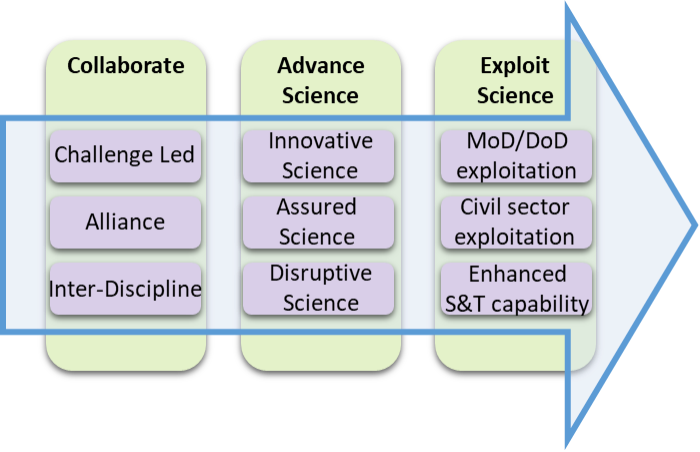Welcome to the legacy site for the Distributed Analytics & Information Sciences (DAIS) International Technology Alliance (ITA): research program. This was an inter-disciplinary US/UK collaboration across government, academia and industry from 2016 to 2021.
The DAIS ITA has delivered world leading inter-disciplinary scientific outputs, enabling generation after next information integration and exploitation, for distributed coalition multi-domain operations in dynamic and contested environments. It has developed the science underpinning the following future military capabilities:
-
Resilient Coalition Networks for Degraded, Intermittent and Latent (DIL) tactical networks including developing a new architecture called Software Defined Coalitions (SDC) for dynamic, agile and robust configuration, provisioning and sharing of information infrastructure assets among coalitions, and techniques for dynamic context-aware management of coalition networks.
- Artificial Intelligence (AI) in Contested Multi-Domain Coalition Operations including:
- Adaptable AI able to rapidly adapt in dynamic situations and learn as the operation proceeds exploiting synergies between humans and machine intelligence;
- Uncertainty-aware AI enabling human users to rapidly achieve an appropriate degree of trust in AI systems when making high-stakes decisions;
- Distributed Coalition AI able to share data and models with partners whilst operating under a range of privacy constraints and in DIL communications environments;
- Distributed Analytics enabling dynamic integration of coalition analytic and information services in (near) real-time in DIL communication environments.
- Integrating ad hoc Coalition Teams and Understanding Dynamic Audiences including (1) techniques to enable assessment of a dynamic information environment, and (2) computational social science for coalition cognitive co-ordination and the evolutionary basis of inter-group conflict.
DAIS ITA was a 5-year (2016-2021) collaborative partnership between the US and UK bringing together researchers from U.S. Army DEVCOM Army Research Laboratory (ARL) and UK Defence Science and Technology Laboratory (Dstl) to work alongside a consortium (led by IBM) of universities and industrial research laboratories in both the US and UK: involving ~70 faculty/research staff and funding a cohort of ~36 PhD students.

It conducted basic research: its outputs include world-leading scientific publications (494 external publications since Sept 2016), open source code, low technology readiness level (TRL) demonstrators and trained researchers (PhDs). It has achieved significant gearing by publishing with 142 researchers from 86 non-DAIS organisations.
Several of these scientific outputs are already transitioning into higher Technology Readiness Level (TRL) civil and military funded development programmes and many more have the potential for transition.
DAIS ITA assured excellence by publishing results at highly selective international conferences (such as the Association for the Advancement of AI (AAAI) Conference on AI) and journals (such as Nature), as well as through an annual independent peer review by a joint US/UK panel of experts. The panel said:
_“Overall, the DAIS-ITA is a challenging, well integrated, and well-managed program. The program addresses a wide range of coalition-relevant problems. The Peer Reviewers are mindful that this is not simple: The Program’s leadership has managed to keep the participants largely focused on militarily – and especially coalition – issues and problems, while keeping the technical level at basic research. This is a rare achievement: to pose (militarily) relevant issues, and thence to encourage the participants – academics, students and industry and laboratory scientists – to abstract these issues to basic research problems with high-value output that is welcomed at selective conferences and in prestigious journals. The Peer Reviewers stress that this, while not quite unique, is extremely rare amongst funded programs.”
In June 2021, the DAIS ITA was the recipient of a team award from the U.S. – UK Science and Technology Stocktake: a testament to the excellence of the scientific collaboration.
Clusters
The legacy of the DAIS ITA comes in two main forms: A list of publications that have arisen from the program, and a set of final showcase demonstrations and presentations that have been designed around a closely linked set of three clusters:
- AI in Contested Multi-Domain Coalition Operations
- Resilient Coalition Networks
- Integrating Ad hoc Coalition Teams and Understanding Dynamic Audiences
At the end of the program a number of awards were given to key work in various categories based on votes from the DAIS leadership team.